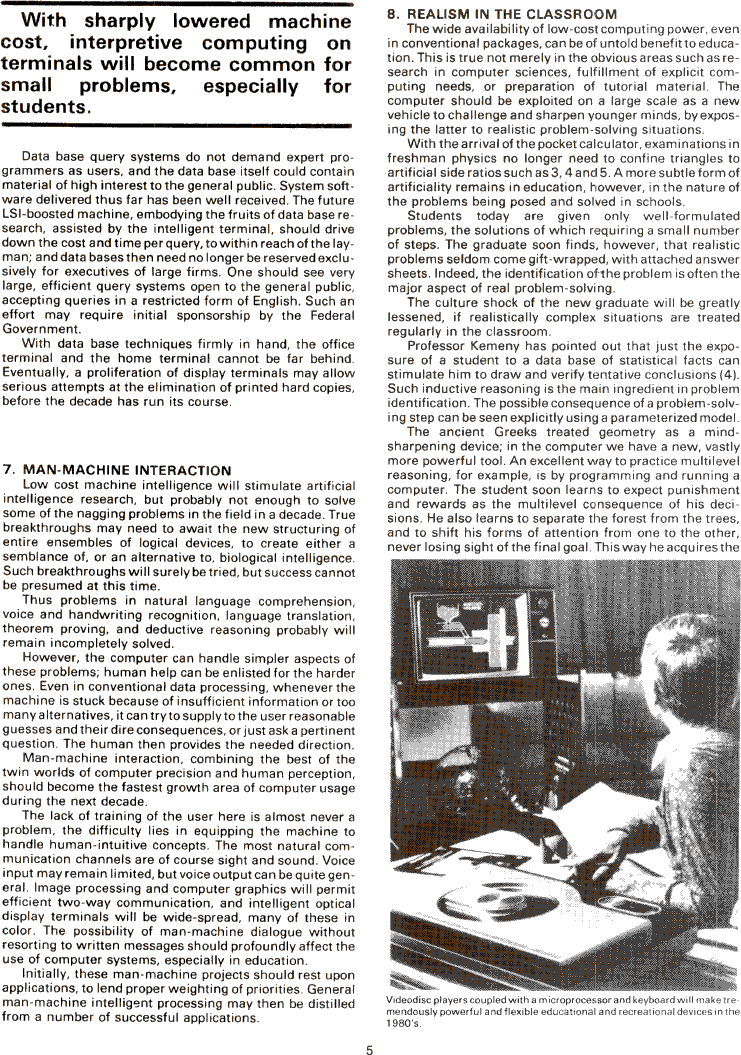The Best of Creative Computing Volume 2 (published 1977)
Computing Power to the People - A Conservative Ten-Year Projection (man-machine interaction, realism in the classroom)

With sharply lowered machine cost, interpretive computing on terminals will
become common for small problems, especially for students.
Data base query systems do not demand expert programmers as users, and the data
base itself could contain material of high interest to the general public.
System software delivered thus far has been well received. The future
LSI-boosted machine, embodying the fruits of data base research, assisted by the
intelligent terminal, should drive down the cost and time per query, to within
reach of the layman; and data bases then need no longer be reserved exclusively
for executives of large firms. One should see very large, efficient query
systems open to the general public, accepting queries in a restricted form of
English. Such an effort may require initial sponsorship by the Federal
Government.
With data base techniques firmly in hand, the office terminal and the home
terminal cannot be far behind. Eventually, a proliferation of display terminals
may allow serious attempts at the elimination of printed hard copies, before the
decade has run its course.
****
7. MAN-MACHINE INTERACTION
Low cost machine intelligence will stimulate artificial intelligence research,
but probably not enough to solve some of the nagging problems in the field in a
decade. True breakthroughs may need to await the new structuring of entire
ensembles of logical devices, to create either a semblance of, or an alternative
to, biological intelligence. Such breakthroughs will surely be tried, but
success cannot be presumed at this time.
Thus problems in natural language comprehension,voice and handwriting
recognition, language translation, theorem proving, and deductive reasoning
probably will remain incompletely solved.
However, the computer can handle simpler aspects of these problems; human help
can be enlisted for the harder
ones. Even in conventional data processing, whenever the machine is stuck
because of insufficient information or too many alternatives, it can try to
supply to the user reasonable guesses and their dire consequences, or just ask a
pertinent question. The human then provides the needed direction.
Man-machine interaction, combining the best of the twin worlds of computer
precision and human perception, should become the fastest growth area of
computer usage during the next decade.
The lack of training of the user here is almost never a problem, the difficulty
lies in equipping the machine to handle human-intuitive concepts. The most
natural communication channels are of course sight and sound. Voice input may
remain limited, but voice output can be quite general. Image processing and
computer graphics will permit efficient two-way communication, and intelligent
optical display terminals will be wide-spread, many of these in color. The
possibility of man-machine dialogue without resorting to written messages should
profoundly affect the use of computer systems, especially in education.
Initially, these man-machine projects should rest upon applications, to lend
proper weighting of priorities. General man-machine intelligent processing may
then be distilled from a number of successful applications.
****
8. REALISM lN THE CLASSROOM
The wide availability of low-cost computing power, even in conventional
packages, can be of untold benefit to education. This is true not merely in the
obvious areas such as research in computer sciences, fulfillment of explicit
computing needs, or preparation of tutorial material. The computer should be
exploited on a large scale as a new vehicle to challenge and sharpen younger
minds, by exposing the latter to realistic problem solving situations.
With the arrival of the pocket calculator, examinations in freshman physics no
longer need to confine triangles to artificial side ratios such as 3, 4 and 5. A
more subtle form of artificiality remains in education, however, in the nature
of the problems being posed and solved in schools.
Students today are given only well-formulated problems, the solutions of which
requiring a small number of steps. The graduate soon finds, however, that
realistic problems seldom come gift-wrapped, with attached answer sheets.
Indeed, the identification of the problem is often the major aspect of real
problem-solving.
The culture shock of the new graduate will be greatly lessened, if realistically
complex situations are treated regularly in the classroom.
Professor Kemeny has pointed out that just the exposure of a student to a data
base of statistical facts can stimulate him to draw and verify tentative
conclusions (4). Such inductive reasoning is the main ingredient in problem
identification. The possible consequence of a problem-solving step can be seen
explicitly using a parameterized model.
The ancient Greeks treated geometry as a mindsharpening device; in the computer
we have a new, vastly
more powerful tool. An excellent way to practice multilevel reasoning, for
example, is by programming and running a computer. The student soon learns to
expect punishment and rewards as the multilevel consequence of his decisions. He
also learns to separate the forest from the trees, and to shift his forms of
attention from one to the other, never losing sight of the final goal. This way
he acquires the
****
[Image]
Videodisc players coupled with a microprocessor and keyboard will make
tremendously powerful and flexible educational and recreational devices in the
198O's.


